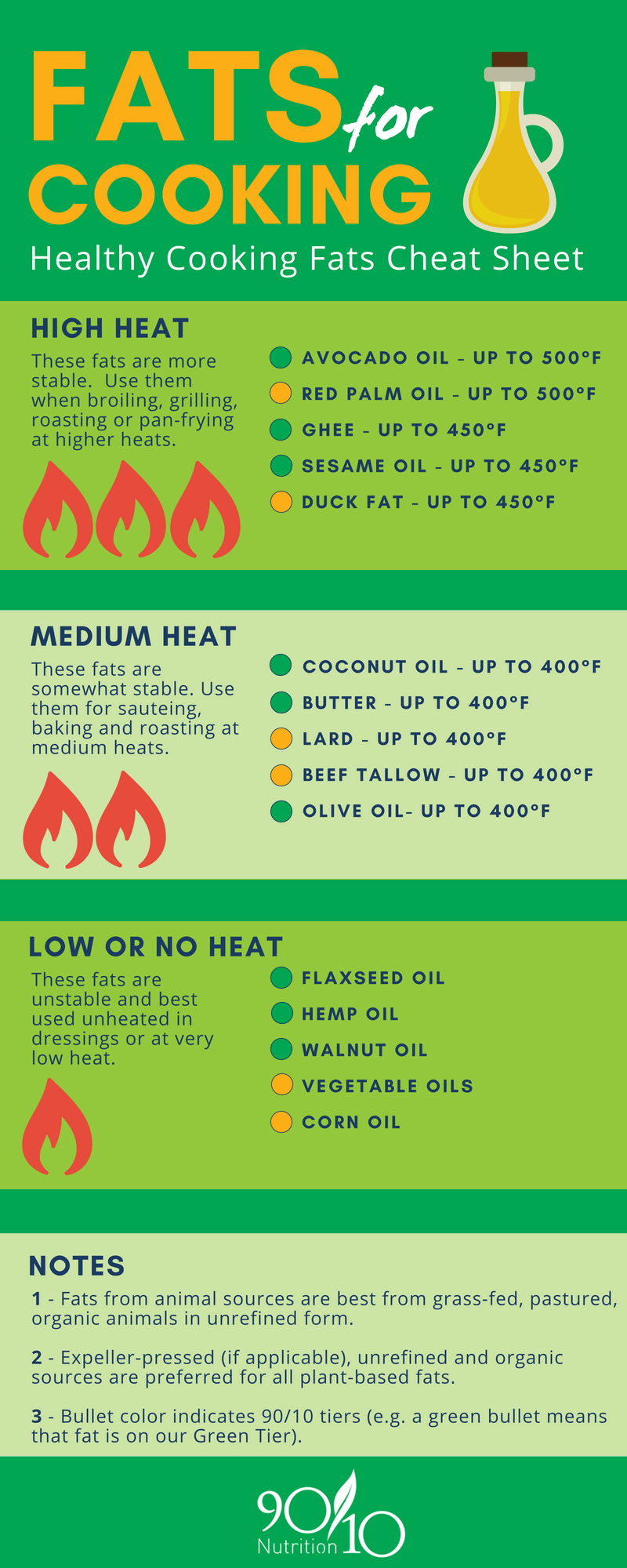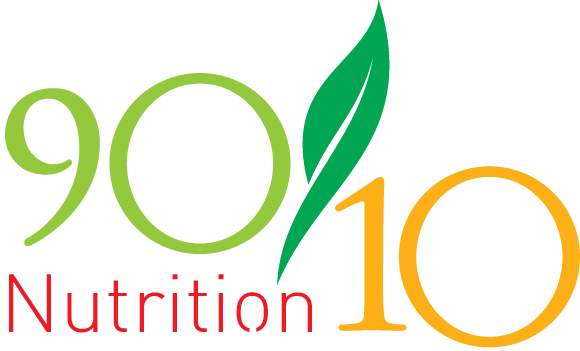Healthy Fats For Cooking
In the first two parts of this blog series (parts 1 and 2), I covered the different types of fats, how much of each type you need, omega-3 and omega-6 fats, inflammation, and much more. In this third part of the blog, I am going to give an overview of healthy fats for cooking.
The big idea here is that some fats are stable when heating and some are not. When you heat fats, they become less stable and subject to oxidation. This is NOT a good thing. So, we’ll go over what that is, how it affects your health, and then which fats to use for which purpose in the kitchen. There’s even a handy infographic you can pin on Pinterest or save somewhere.
Healthy Fats For Cooking
Rancidification, Oxidation, and other "-ations"
When we talk about fats, we often talk about them being “stable” or “unstable”. In general, the more saturated a fat is, the more stable it is. So, fats that are mostly saturated (lard, coconut oil, other animal fats) are usually pretty stable, monounsaturated fats (MUFAs like olive oil) are less stable, and polyunsaturated fats (PUFAs like flaxseed oil) are the most unstable.
Essentially, fats are considered unstable or stable based on how easily they break down and oxidize. They can undergo these chemical changes when exposed to light, heat, and oxygen. The more stable a fat is – which usually corresponds with its degree of saturation as mentioned – the less likely it is to be affected by exposure to light and heat.
When a fat begins to breakdown and oxidize, it can go rancid (really just another way of saying it can “go bad”).
Eating rancid/oxidized oils invites free radicals into your body. Maybe you have heard of “antioxidants” or the antioxidant benefits of certain foods? Antioxidants fight free radicals. Free radicals are basically molecules with an unpaired electron in their outer shell (eek…chemistry!), making them highly reactive in the body. They are out looking for something to bond to and that creates “oxidative stress” on the body. Antioxidants have the ability to donate an electron to free radicals, thereby reducing their ability to react.
All that to say…you don’t want to eat rancid fats.
The Most Stable Fats
The most stable fats are those that are able to handle higher heats without oxidizing or going rancid. This isn’t an exhaustive list, but it covers the fats we use and recommend.
These fats can be used in broiling, grilling, roasting, and frying at higher temperatures.
I note in each description which tier the fat is on in our 90/10 system.
🔥🔥🔥 Avocado Oil (up to ~500°F)
Green Tier – Avocado Oil is extracted from the pulp of the avocado (not the pit). It has a high smoke point and can therefore withstand temperatures higher than olive oil but with similar taste and texture.
🔥🔥🔥 Red Palm Oil (up to ~500°F)
Yellow Tier – Red Palm Oil is one that, as of this writing, we have yet to use in a recipe. It is not to be confused with Palm Kernel Oil which is, to my knowledge, still very unsustainable and damaging to the environment to harvest. Red Palm Oil has a strong flavor similar to paprika and it a great fat for roasting vegetables. I have considered putting this fat on the green tier, but I don’t have enough research to do so yet.
🔥🔥🔥 Ghee (up to ~450°F)
Green Tier – Ghee is a butter fat with the milk solids (casein proteins) removed. Many who are intolerant to dairy (and therefore regular butter) often do fine with Ghee. Ghee is prepared by melting and simmering unsalted butter at a medium temperature until the water content of the butter has evaporated off. The casein separates out and the butterfat is carefully removed, leaving the milk proteins behind. As we discussed in the previous part of this blog series, fat content of animals changes based on the diet they eat. So, if you want the most healthful fat profile, make sure the ghee you purchase is made from organic, grass-fed butter.
🔥🔥🔥 Sesame Oil (up to ~450°F)
Green Tier – Sesame Oil is a relatively stable oil that is about half MUFA and half PUFA. It has a strong flavor and works great in Asian dishes. I use it for light stir-frying mostly.
🔥🔥🔥 Duck Fat (up to ~450°F)
Yellow Tier – Duck Fat is another one that we have never used in a recipe but it is a perfectly viable cooking fat. It’s highly regarded as a healthy fat in Europe. We have it on the yellow tier as we do most saturated animal fats in pure form but it’s certainly debatable. It’s also not something you find easily in the regular grocery store, so I rarely see people using it.
Healthy Fats For Cooking
Healthy Fats For Cooking
The Somewhat Stable Fats
These fats are able to handle medium heats without oxidizing or going rancid.
These fats can be used in roasting, and sauteing at medium temperatures as indicated.
🔥🔥 Coconut Oil (up to ~400°F)
Green Tier – Coconut Oil is a wonderful tropical oil. It is almost fully saturated (92%). It has powerful antimicrobial and antifungal properties and contains lauric acid, which, incidentally, is found in abundant quantities in breast milk. You can combine coconut oil with ghee if you don’t want to taste coconut in a particular recipe. It often works well as is in Thai and Indian recipes where the coconut flavor is welcome.
🔥🔥 Butter (up to ~400°F)
Green Tier – Yes! Butter. Now, just like Ghee and beef, in order to get the very best fat profile, go for the grass-fed, organic variety of butter. There just is no replacement for good quality butter in some recipes and foods.
🔥🔥 Lard (up to ~400°F)
Yellow Tier – Lard (pork fat) is another one that we don’t typically use in recipes because you can’t find it in high quality forms very easily (from pastured, organic animals) and it doesn’t have a good reputation. As I discussed in the first part of this blog series, exchanging animal fats from pastured, organic animals for manufactured fats like trans fats and vegetable shortening doesn’t seem to have done us a lot of good. If you can find a good quality source of real lard, feel free to use it in moderation.
🔥🔥 Beef Tallow (up to ~400°F)
Yellow Tier – Again, I don’t think I have ever even personally used beef tallow (or mutton tallow) in my life. However, just like lard (and possible more so than lard), it’s a perfectly viable cooking fat if you can find organic, pasture-raised and grass-fed sources.
🔥🔥 Olive Oil (up to ~400°F)
Green Tier – The smoking point of olive oil varies depending on if you get extra virgin or virgin as well as how it is pressed and extracted. Some of the purest forms have smoke points as low as 320°F while some more refined versions have smoke points as high as 468°F. There’s no question that olive oil is a healthful oil but there is some question as to how high of a temperature it can tolerate. Some say to only use olive oil as a dressing and drizzling oil and to just be safe and never heat it. Others say you can heat it up to about 400°F safely.
Here’s where we really need to call ourselves out on this subject. We have a few recipes in the database that call for extra virgin olive oil with cooking temperatures as high as 450°F. That’s probably not a good idea. We’ll be going through and changing that to call for avocado oil in the near future. We recommend keeping olive oil in recipes under 400°F.
Healthy Fats For Cooking
The Least Stable Fats
These fats are able to handle very little heat or even light without oxidizing or going rancid.
These fats are best used for dressings and drizzling without heating.
🔥 Flaxseed, Hemp, and Walnut Oil
Green Tier – Use omega-3 rich oils like these sparingly in salad dressings and smoothies. You can also drizzle them over cold soups, appetizers, and dips. Add them to other oils like olive oil to drizzle, or just consume them by themselves is small amounts as a dietary supplement.
🔥 Corn Oil and Vegetable Oils
Yellow Tier – Honestly, I would just stay completely away from vegetable oils and corn oil altogether. There are so many other viable options above and the ability to find non-rancid, unprocessed versions is near impossible. Canola oil falls into this category. I would simply just never use it because there are so many more healthful options. If you do use any of them though, don’t heat them and use them only in small quantities.
Healthy Fats For Cooking - Infographic
Feel free to pin or save the handy infographic below.
Healthy Fats For Cooking

Healthy Fats For Cooking



Comments (2)
Good info that I will put to use.
So, I had bought a bottle of avocado oil recently & wasn’t sure how I was going to use the rest.
This would be good for stir frying then?????
Yes! It works great